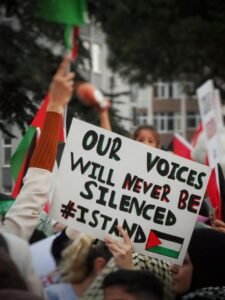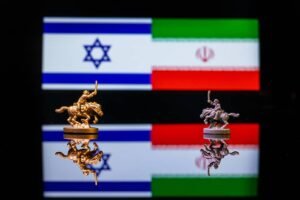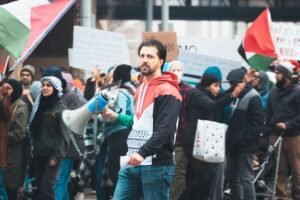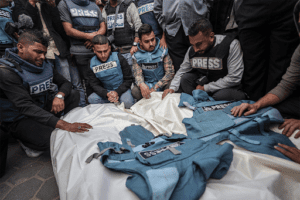I have not found a more accurate place than the complex, simultaneous scene between the Hamas movement and its rival, Israel, for the theories of the godfather of warfare, Carl von Clausewitz, to apply. The ethical confusion of the concepts of American neoliberalism in particular and of Western post-colonialism, in general, occurs when dealing with the sudden advancement accomplished by Hamas and other Palestinian armed factions. It is however difficult to explain the disciplined approach by Hamas since October 7, without generative and intelligent analyses in the regional and international arenas.
The Panoptican is in your head!
Hamas is not a rootless player. The dilemma of denouncing Hamas altogether is much more complicated than a moral judgment or some measurement of an ideological compass. Hamas is either demonised or glorified, seen as an absolute terrorist or a longed-for hero. This is problematic in retrospect since it is only possible to determine one’s stance from an ideological entity, any entity, through an objective tool of analysis, deep-rooted contextual knowledge and a consistent ethical code of measurement. In the absence of the latter, there may not be one lens to look into Hamas.
To demonise or glorify Hamas as a non-state player, we need to redefine it in terms of abilities both as a ruler of Gaza in a state-like manner and as an armed faction with a certain ideology born and re-emphasised over time. Can we identify Hamas as a militia then? Technically yes. Even though the term militia is restricted in International Relations to identify non-state armed groups that are pro-government, the reality of militia is a military force raised from the civilian population of a country or region to supplement a regular army in an emergency as distinguished from mercenaries or professional soldiers. Hence, Hamas as far as we are concerned is a national armed movement that came from the Palestinian community to supplement the Palestinian apparatus since the movement started ruling the Gaza Strip in 2005 winning the legislative elections fair and square. In this sense, Hamas does not differ much from Fateh movement back when it started. The difference is Fateh and other non-armed movements forming the PLO have turned into bureaucracies surrounding themselves with associated costal service networks and international community recognition. Hence, The PLO enjoys more spheres in the international community over Hamas, yet does not have sovereignty due to the lack of recognition, at least on the UN chart of full state members.
“Engage the enemy and see what happens. The leader puts himself in the hands of chance, they stand in his hands, and his will to use them will enable him to transform coincidence into a new reality. Genius is the force capable and most effective of creating and exploiting this truth.”
Hamas, i.e. the Palestinian resistance by definition, with all its heavy impact on the current Israeli security scene, has suddenly reproduced itself in the void, balancing the zero-sum Israeli-Palestinian equation. The Israeli tactical withdrawal from the Gaza Strip in 2005 aimed in vain to mend the military and security failure under the weight of confrontations above and underground. The fact that both Hamas and Islamic Jihad were tinged with political and Salafist Islam, respectively did not push Palestinian voters away, nor the Western players from the potential negotiating table. The reality though since October 7, was a dull plan to encircle the Gaza Strip and detain approximately two and a half million Palestinians inside it. It is by definition a collective punishment that is criminalised by the clearest international laws and has even dashed any hope for an intended peace.
“War is not just a political act, but a real political tool, a continuation of political engagement, the implementation of the ordinary by different means.”
Netanyahu’s statement following the first salvo of Hamas rockets was not emotional or spur of the moment. It was political. Perhaps his only traitorous reaction was adding the term “lethal” to the word attack. The following weeks proved that Hamas’s attack was indeed deadly, politically as well as operationally. Ironically, this term cost Netanyahu nearly five months of deliberately exaggerating the commission of a full-fledged crime of genocide, which greatly embarrassed all of his allies who tried desperately to dilute reality and remove sympathy from it, sometimes by reducing the thousands of lives claimed by Israel’s war on civilians in the Gaza Strip into numbers.
One may believe that Netanyahu wants Hamas wiped off the face of the earth. The truth is Israel is indispensable to Hamas and the resistance and is even desperate in its need for them. Hamas is Netanyahu’s most effective means to alienate his fiercest opponents and to appeal to his most ferocious voters. If Hamas disappears, Netanyahu’s favorite narrative of survival will disappear. Israel’s arguments for the necessity of arming will disappear, and the superiority of an armed Israel in the Middle East will be destroyed.
“This is called using the spoils of a conquered enemy to increase our own strength. So let your first and greatest concern in war be achieving victory, not prolonging military campaigns.”
I do not think that the surprise of the extremely precise and brutal operation carried out by the Qassam Brigades was to Israel alone, it was to The Palestinian Authority as well. The straight timeline of operations extends the gap in operational skills between The PLO and the Palestinian factions. The margins for political maneuvers by Mahmoud Abbas and Fateh leaders tighten. It is no longer reprehensible to criticize Hamas, not only because of its position on Israel’s transgressions but also its refusal to submit to the superiority of the Palestinian Liberation Organization. Hamas invested skillfully and intentionally in their victory over Israel as well as in the competition with the Palestinian Authority.
When the President of the PLO Mahmoud Abbas, announced a unilateral withdrawal from Oslo in a regular session of the United Nations in September 2015 no one believed. Needless to say, he retreated. On October 7, no one believed the Palestinian Authority’s attempt to adapt Hamas’s resounding victory, nor the hasty attempt to line up, declaring that the October 7 operation was “a natural response to the continuing Israeli aggression against the Palestinians and Islamic and Christian sanctities.” The announcement is in itself an admission of the failure to have a monopoly over coercion or provide any satisfactory political solution.
“Make sure to appear at points that the enemy must rush to defend, and walk as quickly as possible to places where you are not supposed to be.”
Resistance operations in Gaza cannot sustain any victory without levelling the scales in the occupied West Bank and Jerusalem. Two years ago, the fire that broke out in Sheikh Jarrah in occupied East Jerusalem fueled the resistance front in Gaza, granting the armed struggle an electoral ticket in voting circles in Jerusalem. Hamas’ military response gained firm ground in the Palestinian collective conscience, constituting pre-emptive pressure on the PLO, forcing the Fateh movement to postpone its legislative elections indefinitely.
The successful operations of the Palestinian resistance also helped raise the stakes for Hamas. The announced victory despite the civilian losses instilled a spirit of adventure and encouraged various lone-wolf operations in the West Bank. The assassination of Gal, the son of Ghazi Eisenkot, a member of the Israeli War Council and the former chief of staff, and then his nephew, Officer Maor Cohen, topped Hama’s systematic advancement and affirmed the footprint of armed resistance. In the third and last article, I will look into the Israeli response and the change of warfare character in the Middle East accordingly.









